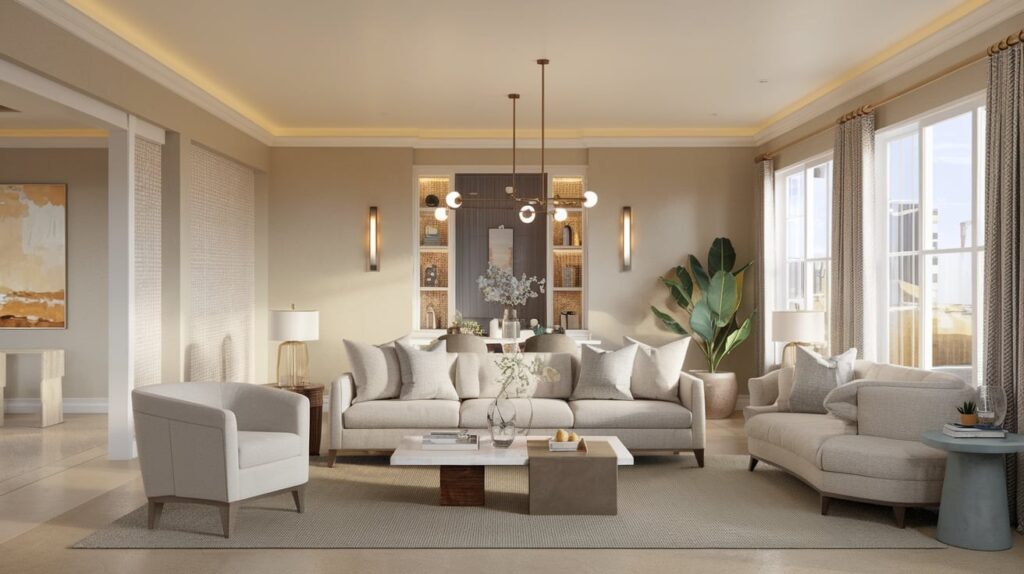When it comes to selling a home, buyers don’t just purchase walls and square footage, they buy emotion. A space that feels warm, open, and balanced instantly creates a sense of belonging. Whether you’re preparing to list or aiming to sell your house fast in Maryland, the atmosphere inside can be the deciding factor that turns curiosity into commitment.
The good news? You don’t need a complete renovation to make a strong impression. Strategic use of color, lighting, and layout can dramatically elevate how buyers experience your home, creating interiors that feel both aspirational and attainable.
Color: The Emotional Architecture of a Room
Color is one of the simplest yet most powerful design tools. It has the ability to alter perception, set tone, and even affect how spacious a room feels. Buyers often make subconscious judgments within seconds, and color plays a leading role in that first impression.
Choosing a Cohesive Palette
A unified palette makes your home feel intentional and calm. Stick to neutral or earth-based tones, soft whites, beige, sand, or greige (a mix of gray and beige), to appeal to the widest range of buyers. These colors reflect light beautifully and act as a backdrop for personal imagination.
If you want to introduce subtle personality, consider muted accent hues. A pale sage in the kitchen, a soft navy in the dining area, or a terracotta feature wall in the living room can add warmth without overwhelming. The goal is balance, color should support emotion, not dictate it.
The Psychology of Color
According to Better Homes & Gardens, buyers respond most positively to colors that evoke relaxation, stability, and freshness. Blues and greens promote calm, while soft yellows bring energy and optimism.
Avoid overly bold or dark tones unless they’re balanced by ample natural light. What feels stylish to you might feel claustrophobic or too “personalized” to a potential buyer. In staging, neutrality equals versatility, and versatility sells.
Lighting: Designing with Illumination
Light is the secret ingredient that brings interiors to life. It defines depth, highlights texture, and enhances mood. The right lighting plan can make even modest rooms feel sophisticated and expansive.
Maximize Natural Light
Start by examining how sunlight interacts with each room. Remove heavy drapes, clean windows, and use lighter sheers to diffuse brightness. Mirrors opposite windows can double perceived light and create dimension.
If your home lacks strong natural light, adjust your color palette to compensate, warm neutrals reflect artificial light better than cool grays. You can also experiment with semi-gloss finishes that subtly bounce light around.
Layer Artificial Light Thoughtfully
Great lighting isn’t about a single fixture; it’s about layering. Combine ambient (overhead), task (focused), and accent (decorative) lighting to create flexibility and ambiance.
- Ambient: Install dimmable ceiling fixtures or recessed lights to control brightness throughout the day.
- Task: Add focused lighting for reading corners, kitchen counters, or vanity areas.
- Accent: Use wall sconces or statement lamps to draw attention to art, texture, or architectural features.
A home with layered lighting feels intentional and cared for, qualities that buyers instinctively associate with value and comfort.
Layout: Flow, Function, and Feel
Even the most beautiful colors and lighting fall flat if a room’s layout feels awkward. Buyers need to imagine living in the space, moving fluidly from one zone to another, picturing gatherings, routines, and moments.
Open Flow and Defined Purpose
Modern buyers love open-concept layouts, but that doesn’t mean every space should blur together. Create definition through thoughtful furniture placement and visual cues. For example:
- A rug can distinguish the living area from the dining space.
- Console tables or low shelving can subtly guide pathways without blocking sightlines.
- Chairs angled toward each other foster connection, perfect for showing off a cozy conversation corner.
The idea is to encourage exploration while maintaining harmony. Every room should feel distinct, yet connected to the next.
Declutter for Space and Scale
Rooms always feel larger when visual noise is reduced. Before listing, remove about one-third of your belongings, particularly oversized furniture, personal decor, or excessive wall art. Keep surfaces clean, symmetrical, and purposeful.
If possible, stage with pieces that match the scale of the room. Oversized sectionals or massive dining tables can make even large spaces feel cramped. Simplicity gives buyers breathing room to imagine their own style within the space.
Texture and Detail: The Finishing Touches
While color and layout capture attention, texture and small details create emotional resonance. Add tactile variety, a woven throw, a velvet cushion, a natural jute rug, to make rooms feel layered and inviting.
These accents also photograph beautifully, which is critical since most buyers first encounter listings online. Even the suggestion of comfort (a soft blanket, a well-placed plant, a vase of fresh greenery) can transform the feel of a space from ordinary to memorable.
Don’t underestimate the power of scent either. A subtle, clean aroma, fresh linen, cedar, or citrus, can reinforce a sense of care and cleanliness.
Why Emotional Design Sells
When potential buyers walk into a home, they’re subconsciously asking, “Can I see myself here?” Design that answers “yes” does more than please the eye, it evokes belonging.
Every color choice, beam of light, and spatial flow contributes to that emotional resonance. A warm palette whispers calm. Natural light signals openness. Balanced layout suggests ease and confidence. Together, they create harmony, and harmony sells.
Even in competitive markets, homes that feel good move faster and attract stronger offers. The visual language of comfort and care speaks louder than any sales pitch.
Creating an inviting interior doesn’t require a design degree or a massive budget. It’s about making intentional choices that help buyers connect emotionally with the space.
By mastering color, optimizing light, and refining layout, you turn walls into a story, one that buyers want to be part of. And whether you’re staging for open houses or looking to sell your house fast in Maryland, that emotional connection is what truly turns interest into offers.

